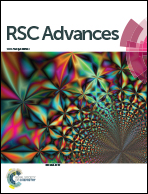Self-assembly of photoresponsive azo-containing phospholipids with a polar group as the tail†
Abstract
Vesicles or micelles prepared from amphiphiles with azobenzene (Az) moieties and long alkyl chains have attracted much attention in drug delivery systems. To induce release behavior from smart carriers via trans–cis photoisomerization of the Az groups, UV light exposure is typically used, but it can damage DNA and hardly penetrates cells. In this paper, Az-containing phospholipids without long alkyl tails were designed and synthesized; in these compounds, the end group of the Az moiety was substituted with a –NO2 and –OCH3 group (abbreviated N6 and M6, respectively). N6 self-assembled into H-aggregates with an interdigitated bilayered structure in water through the antiparallel orientation due to π–π interactions of the Az group, the attractive van der Waals forces, and the interactions and bending behavior of the phosphocholine groups. Vesicles showing visible light stimuli-responsive behavior were obtained by mixing N6 and M6, and the release of encapsulated calcein was triggered by visible light.



 Please wait while we load your content...
Please wait while we load your content...